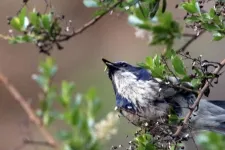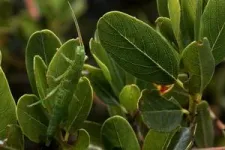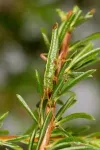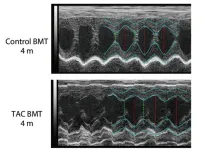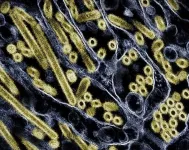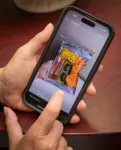(Press-News.org) LOGAN, UTAH, USA – A long-standing debate among evolutionary scientists goes something like this: Does evolution happen in a predictable pattern or does it depend on chance events and contingency? That is, if you could turn back the clock, as celebrated scientist Stephen Jay Gould (1941-2002) described in his famous metaphor, “Replaying the Tape of Life,” would life on Earth evolve, once again, as something similar to what we know now, or would it look very, very different?
“If you frame it as an either/or question, it’s too simplistic,” says Utah State University evolutionary biologist Zachariah Gompert. “The answer isn’t ‘completely random’ or ‘completely deterministic and predictable.’ And yet, examining short time scales, we can find predictable, repeatable evolutionary patterns.”
Gompert and colleagues report evidence of repeatable evolution in populations of stick insects in the May 24, 2024, online edition of the American Association for the Advancement of Science’s journal Science Advances. Collaborating authors on the paper include Gompert’s long-time collaborator Patrik Nosil and other researchers from France’s University of Montpelier, Brazil’s Federal University of São Paulo, the University of Nevada, Reno and Notre Dame University. The research is supported by the National Science Foundation and the European Research Council.
The team examined three decades of data on the frequency of cryptic color-pattern morphs in the stick insect species Timema cristinae in ten naturally replicate populations in California. T. cristinae is polymorphic in regard to its body color and pattern. Some insects are green, which allows the wingless, plant-feeding insect to blend in with California lilac (Ceanothus spinosus) shrubs. In contrast, green striped morphs disappear against chamise (Adenostoma fasciculatum) shrubs.
Hiding amongst the plants is one of T. christinae’s key defenses as hungry birds, such as scrub jays, are insatiable predators of the stick insects.
“Bird predation is a constant driver shaping the insects’ organismal traits, including coloration and striped vs. non-striped,” says Gompert, associate professor in USU’s Department of Biology and the USU Ecology Center. “We observed predictable ‘up-and-down’ fluctuations in stripe frequency in all populations, representing repeatable evolutionary dynamics based on standing genetic variation.”
He says a field experiment demonstrates these fluctuations involved negative frequency-dependent natural selection (NFDS), where cryptic color patterns are more beneficial when rare rather than common. This is likely because birds develop a ‘search image’ for very abundant prey.
“At short time scales, evolution involving existing variations can be quite predictable,” says Gompert, who received a National Science Foundation CAREER grant in 2019 to support his research. “You can count on certain drivers always being there, such as birds feeding on the insects.”
But at longer time scales, evolutionary dynamics become less predictable.
“The populations might experience a chance event, such as a severe drought or a flooding event, that disrupts the status quo and thus, the predictable outcomes,” Gompert says.
On long time scales, a new mutation in the species could introduce a rare trait, he says. “That’s about as close to truly random as you can get.”
“Rare things are easily lost by chance, so there’s a strong probability a new mutation could disappear before it gains a stronghold,” he says. “Indeed, another species of Timema stick insect that also feeds on chamise either never had or quickly lost the mutations making the cryptic stripe trait. Thus, the evolution of stripe is not a repeatable outcome of evolution at this long scale.”
Gompert notes replicated, long-term studies from natural populations, including research on the famous Darwin’s finches, are rare.
“Because most of this work is restricted to one or few populations, it is difficult to draw inferences on repeatability among multiple evolutionary independent populations,” he says. “Such studies are challenging to implement not only because they take concerted effort, but also because you can’t rush time.”
Gompert, who is designated a High Ranked Scholar by ScholarGPS, has developed, with USU colleagues, a research-intensive, interactive introductory biology laboratory class to introduce undergraduates to research. He and colleagues also developed an interactive presentation about evolution for all ages, called “Nabokov’s Butterflies,” that was presented at the USU College of Science’s Science Unwrapped public outreach program in 2022.
###
END
The stress of heart failure is remembered by the body and appears to lead to recurrent failure, along with other related health issues, according to new research. Researchers have found that heart failure leaves a “stress memory” in the form of changes to the DNA modification of hematopoietic stem cells, which are involved in the production of blood and immune cells called macrophages. These immune cells play an important role in protecting heart health. However, a key signaling pathway (a chain of molecules which ...
Scientists have pinpointed genetic changes that can leave children born with little to no immune defence against infection.
In a new study of 11 affected individuals, researchers from Newcastle University, the Wellcome Sanger Institute, the Great North Children’s Hospital, and their collaborators were able to link mutations in the NUDCD3 gene to Severe Combined Immunodeficiency and Omenn syndrome1 – rare and life-threatening immunodeficiency disorders. These mutations prevented the normal development of diverse immune cells needed to combat different pathogens2.
The findings, published today (24 May) in Science Immunology, ...
LAWRENCE — Using data from the Transiting Exoplanet Survey Satellite and W.M. Keck Observatory on Mauna Kea in Hawaii, an astronomer at the University of Kansas led a study appearing today revealing 15 new exoplanets — planets beyond our solar system — along with the mass of 126 other exoplanets. The findings give astronomers new understanding of the makeup of exoplanets and their star systems generally.
The study cataloging the exoplanets — comprising severe and exceptional environments, some of which hold promise to support life — was conducted under auspices of the TESS-Keck Survey and appears ...
WHAT:
Mice administered raw milk samples from dairy cows infected with H5N1 influenza experienced high virus levels in their respiratory organs and lower virus levels in other vital organs, according to findings published in the New England Journal of Medicine. The results suggest that consumption of raw milk by animals poses a risk for H5N1 infection and raises questions about its potential risk in humans.
Since 2003, H5N1 influenza viruses have circulated in 23 countries, primarily affecting wild birds and poultry with about 900 human cases, primarily among people who have had close contact with infected birds. In ...
Researchers at the U of A found self-identified small business owners on TikTok are circumventing a number of local, state and federal laws that restrict the individual sale of tobacco products. Specifically, the researchers found that 45% of the videos highlighted the fact that they did not require identification to verify the purchaser’s age.
“Many states have laws that govern procedures necessary to sell e-cigarettes,” explained lead researcher Page Dobbs, an associate professor of public health in the Department of Health, Human Performance and Recreation ...
Leading African scientists have issued a compelling call for more equitable research partnerships in a new paper published in Nature Medicine. The paper underscores the critical need for fair and collaborative research efforts to explore the unique and diverse microbiomes found in African populations and environments. Historically, these microbiomes have been underrepresented in global studies.
Over the past two decades, our understanding of the role played by the microbiome in different ecosystems has significantly expanded. For ...
LA JOLLA, CA—New research from scientists at La Jolla Institute for Immunology (LJI) suggests people who received COVID-19 vaccines and then experienced "breakthrough" infections are especially well armed against future SARS-CoV-2 infections.
By analyzing blood samples from study volunteers, the LJI researchers discovered that people who experienced symptomatic breakthrough infections develop T cells that are better at recognizing and targeting SARS-CoV-2, including the Omicron and Delta variants. The researchers describe this increased protection as an "immunity wall."
"The virus evolves, but, importantly, so does the immune system. T cells ...
May 24, 2024 --
A team of international scientists, including Virginia Tech entomologist Warren Booth, have solved the 250-year-old origin puzzle of the most prevalent indoor urban pest insect on the planet: the German cockroach.
The team's research findings, representing the genomic analyses of over 280 specimens from 17 countries and six continents, show that this species evolved some 2,100 years ago from an outside species in Asia and were released this week in the Proceedings of the National Academy of Sciences journal.
One ...
Get introduced to the latest advances in skin research at the 15th International Conference on Skin Ageing & Challenges 2024 on November 5-6 at Corinthia Palace in Malta.
Skin Ageing & Challenges 2024 will cover the hottest topics shaping the future of skin aging and rejuvenation.
How will Skin Ageing & Challenges 2024 Expand Your Knowledge?
Senolytics: Exploring new ways to fight cell aging with innovative senolytic treatments.
Extracellular Vesicles: Discovering the potential of EVs for skin regeneration and repair.
Skin Microbiota / Mitochondria Transplantation: Introducing approaches to harness the power of microbiome and mitochondrial transplantation ...
Carbon dioxide is the greenhouse gas, singlehandedly responsible for 78% of the change in energy balance in Earth's atmosphere between 1990 and 2022.
A byproduct of burning fossil fuels, carbon dioxide enters the atmosphere from car exhaust and coal-fired power plants. Even some renewable energy resources produce a small amount of carbon dioxide, although at a tiny fraction of the amount coal and natural gas create.
At its core, this molecule is just an arrangement of one carbon and two oxygen atoms that can be reorganized through a ...
